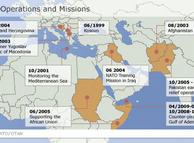NATO 2020: Downsizing Instead of Reshaping
Note:
My article was originally published on August 30, 2010 as OP-ED in a collaborative project to create recommendations for NATO’s new Strategic Concept by Atlantic-Community.Org (open think tank).
![]() Ari RUSILA: Rather than providing for collective defense, today’s Alliance is invited to join American wars. Instead of scribbling a new Strategic Concept for NATO that will preserve the dominant position of the US, it might be wiser for European states to develop a New Security Structure within the EU to replace the Cold War relic.
Ari RUSILA: Rather than providing for collective defense, today’s Alliance is invited to join American wars. Instead of scribbling a new Strategic Concept for NATO that will preserve the dominant position of the US, it might be wiser for European states to develop a New Security Structure within the EU to replace the Cold War relic.
During last sixty years, the security environment and NATO's role within it have both changed considerably. Threats are more diverse, as the main enemy of the Alliance disappeared in the 1990s. An attack in North America or Europe by the army of an outside state is highly unlikely. Instead of providing for collective defense, NATO is invited to fight US wars by attacking sovereign states. While experts are busy planning the new Strategic Concept, they have avoided a core question: Is NATO needed in the post-Cold War security structure, or could today's challenges be better met by replacing the Alliance with existing, modernized organizations?
Attack is the Best Defense?
Today's NATO is an extension of US State Department, where the role of other members is to support US wars, guarantee the quarterly profits of the US military-industrial complex (MIC), and try to cover damages and failures of these aggressions economically by using "soft power."

From her side, the US is motivated by the prospect of gaining control over the world's main energy resources. Examples include the US "Silk Road Strategy" (SRS) and the GUUAM (Georgia, Ukraine, Uzbekistan, Azerbaijan and Moldova) Group, which aimed to block Russia from gas fields in the Caspian Sea, cut her connection to Iran, and isolate Moscow politically. Most conflicts from the Balkans to Afghanistan have their roots in the SRS. Russia's counter actions have been successful, and both the SRS strategy and GUUAM have been failures. Today, the main focus of the US is to keep a foothold in Central and South Asia and to prevent the expansion of China. NATO's role is to provide political backing and financial support for these American foreign policy goals, and does not necessarily reflect the EU's interests (read more in my article Is GUUAM dead?).
Threats Today and in the Near Future
The collapse of Communism removed the original idea of NATO's existence, and among the Allies there is a growing fatigue to participate in real or imaginary attacks around the world led by an American cowboy policy. The changed security environment has raised the question of NATO's continuing relevance, and so a new Strategic Concept is being developed to define new threats in order to legitimate the Alliance's existence. The following can have some relevance:
- Nuclear weapons and other weapons of mass destruction (WMD), and their means of delivery, whether in the hands of irresponsible states or non-state actors.
- Malevolent use of modern technology and information systems by individuals, organizations and states to target the vulnerable areas of societies is today's reality - cyber space is a growing battlefield.
- Globalization is making borders more fluid, so the flow of goods, services, people, technology, crime and weapons is increasing. Open borders can be used to harm different societies by groups with political, religious, economic, or criminal motivations. Also, the communication, transport, and transit routes that link the multi-polar world together are increasingly vulnerable.
- Climate change, migration of people, struggle over raw materials, and clean water can also be the cause of future conflicts.
- Intrastate conflicts will continue, caused by both ethnic and economic factors.
The New Security Structure
The New Security Structure – which could replace NATO - should in my opinion cover the whole crisis cycle, from prevention to crisis management to post-crisis stabilization and capacity-building measures. From the EU perspective, the core of this structure should be a combination of the European Security and Defence Policy (ESDP), the Common Foreign and Security Policy (CFSP), and EU Battlegroups (EUBG). An even wider structure could be created by reinforcing the OSCE as the main security organization in Europe, but this may require a longer time. In order to respond to today's threats, the ESDP/CFSP/EUBG should coordinate its activities with the UN/Department of Peacekeeping Operations (world wide crisis cycle management), the IAEA (nuclear and other WMD), Interpol/Europol (organized crime, cyberwar) and FRONTEX (borders).
One crucial question, at least during the transitional period from NATO to the New Security Structure, is the coordination of US hard power with EU soft power in ongoing operations. If EUBG is not enough, more military muscle can be provided by the US. However, America will only help its European partners if the US military-industrial complex has some interest in doing so. Additionally, private firms will be more than ready to take on the dirty jobs: assassinations of terrorists, torture, and trafficking, among others (as they are currently doing in Pakistan on the CIAs payroll). Europe must work to establish its own security structure in order to free itself from the obligation of being complicit in such tactics, which are accepted means of defending and spreading western democratic values under the current US-dominated Alliance.
![]()
Comments